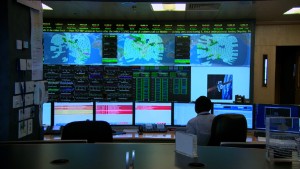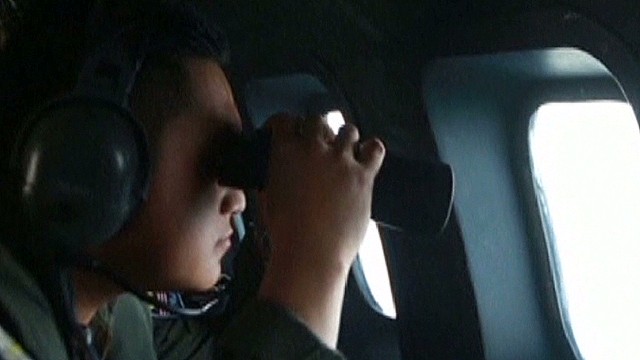
New satellite images
provided by a French defense firm show 122 objects floating in the
southern Indian Ocean, not far from other satellite sightings that could
be related to missing Malaysia Airlines Flight 370, the Malaysian
transport minister said Wednesday.
The objects were
scattered over 154 square miles (400 square kilometers), acting
Transportation Minister Hishammuddin Bin Hussein said.
Hishammuddin said he
wasn't sure if Australian authorities coordinating the search for the
plane had been able to follow up Wednesday on the new satellite images,
which came from Airbus Defence and Space.
Searches resumed
Wednesday after a one-day delay caused by poor weather. However, the
last of 12 planes dispatched to the site returned to its base in Perth,
Australia, late Wednesday without finding anything definitive,
Australian officials said.
 Photos: The search for Malaysia Airlines Flight 370
Photos: The search for Malaysia Airlines Flight 370

'Eventually something will come to light'

How Inmarsat found MH370's path

Wife grieves for husband missing on MH370
Search aircraft did spot three objects, but none were obvious plane parts, the Australian Maritime Safety Agency said.
The latest objects seen
on satellite range from about 3 feet (1 meter) to about 75 feet (23
meters), Hishammuddin said. Some appear bright, indicating they may be
solid, he said.
The latest images appear
to be the most significant discovery yet in the hunt for the missing
plane, which vanished March 8 with 239 people aboard, said CNN aviation
analyst Miles O'Brien.
"There's a very good chance this could be the break we've been waiting for," he said.
Aviation safety analyst David Soucie agreed, saying he was particularly intrigued by the size of the 75-foot object.
"It has potential to be a wing that's floating," he said. "So I'm really encouraged by it, I really am."
But satellites have
captured images of objects before during the current search, and crews
have yet to spot anything definitively linked to the airplane, and ships
haven't recovered anything of note.
Officials have warned
that objects spotted in the water may turn out to be flotsam from cargo
ships, and that finding anything from the plane could still take a long
time.
"There's always a
possibility we might not actually find something next week or the week
after," Mark Binskin, vice chief of the Australian Defence Force, told
CNN's Kate Bolduan on Tuesday. "I think eventually, something will come
to light, but it's going to take time."
Seven military
reconnaissance planes -- from Australia, China, New Zealand, the United
States, Japan and South Korea -- and five civil aircraft are combing the
vast search area, which covers 469,407 square nautical miles.
Five ships, one from Australia and four from China, also are in the search zone, Australian authorities said.
The hardware
If search teams are able
to find debris confirmed to be from the plane, it would help officials
figure out roughly where the aircraft went down.
They would then be able
to focus the search under the water to try to find larger pieces of
wreckage and the all-important flight data recorder, which may hold
vital clues about what happened on board the night the plane
disappeared.
U.S. hardware designed
to help with that task arrived Wednesday in Perth, the western
Australian city that is the base for the search efforts.
The United States sent a
Bluefin-21 autonomous underwater vehicle, which can search for
submerged objects at depths as low as 14,700 feet (4,480 meters), and a
TPL-25, a giant listening device that can help pinpoint the location of
pings from the flight data recorder. Towed behind a ship, the TPL-25 can
detect pings at a maximum depth of 20,000 feet (6,096 meters).
Time is against that
part of the search though as the plane's pinger is expected to run out
of power within the next two weeks. The Indian Ocean has an average
depth of about 13,000 feet (3,962 meters),

Source: Flight 370 turned, dropped

Flight 370 relative: This is a cover-up

Families told all lives are lost
The families
The wait for answers
about what happened to the plane and where it is now has taken a toll on
the family members of those on board.
Chinese relatives have been particularly upset by Malaysian authorities' announcement Monday,
based on analysis of satellite data, that the plane had crashed into
the southern Indian Ocean with the loss of all lives aboard.
"My heart can't handle
it. I don't want to hurt my children," Cheng Li Ping told CNN on
Wednesday as she waited in Kuala Lumpur for evidence about what happened
to her husband, who was aboard Flight 370.
The Chinese citizen says
she cannot bring herself to accept that her husband is dead, even after
authorities announced there were no survivors.
"I can't trust the
Malaysian government. I can't work now because all I can think about is
my husband and my children," she told CNN's Sara Sidner. "I don't have
strength. ... My head is a mess."
On Wednesday, some
families accused Malaysia Airlines of falling short on its promises to
provide volunteer caregivers and accommodations for some family members.
The airline couldn't immediately be reached for comment and did not
send a representative to a press conference Wednesday.
The complaints came a day after hundreds of Flight 370 family members marched to the Malaysian Embassy in Beijing to voice their anger and frustration.
Some argued the Malaysian government was covering up the truth and demanded tangible evidence the plane had ended up in the ocean.
The Chinese government,
whose citizens made up two-thirds of the passengers on board the missing
plane, also said it wanted more information from Malaysia. President Xi Jinping has sent a special envoy to Kuala Lumpur to deal with the matter.
The Malaysian officials
met with the Chinese envoy Wednesday, said Hishammuddin, the transport
minister, and briefed them extensively on the analysis of the satellite
data that led to the crash conclusion.
The backlash
The Malaysians' comments
appeared to have done little to placate the anger among the families,
however, and it appeared to be spreading more widely among the Chinese
public.
Some Chinese celebrities used social media to urge people to boycott Malaysian products and visits to the country.
Chen Kun, one of China's
most popular actors, accused the Malaysian government and Malaysia
Airlines of "clownish prevarication and lies." His post Tuesday calling
for a boycott was reposted more than 65,000 times on Weibo, China's
Twitter-like microblogging platform.
"I've never been to
Malaysia, and I will no longer plan to go there anymore," Meng Fei, the
host of one of China's most popular TV shows, wrote Wednesday on Weibo,
calling for others to repost the comments if they felt the same. More
than 120,000 users did.
Other social media users, albeit with smaller followings, argued against punishing Malaysia over the matter.
Chen Shu, a journalist, warned a boycott would "hurt the relationship of Chinese and Malaysians" and long-term regional ties.
Chinese authorities
regularly censor Weibo posts. The fact the anti-Malaysian posts by
high-profile users weren't deleted suggested either tacit approval or at
least an unwillingness to wade into the debate by Chinese government
censors.
Hishammuddin, however,
praised his country's performance, saying officials had overcome
significant diplomatic challenges to bring together 26 countries, at one
point, to participate in the search.
"History will judge us well," he said.
Legal action
In the United States, meanwhile, a Chicago-based attorney has taken the first formal legal steps related to the missing plane.
Monica Kelly, a lawyer
at Ribbeck Law, asked an Illinois state judge Tuesday to order Malaysia
Airlines and Boeing, which manufactured the missing airplane, to provide
documents and other information.
Kelly is seeking
specific information about the airline's batteries, details on the fire
and oxygen systems, and records related to the fuselage.
The filing appears to be
the first move toward U.S.-based litigation stemming from the plane's
March 8 disappearance. The firm said it plans to build a
multimillion-dollar suit against the airline and Boeing.
Boeing declined to comment on the matter late Tuesday, and Malaysia Airlines officials weren't immediately available.




































